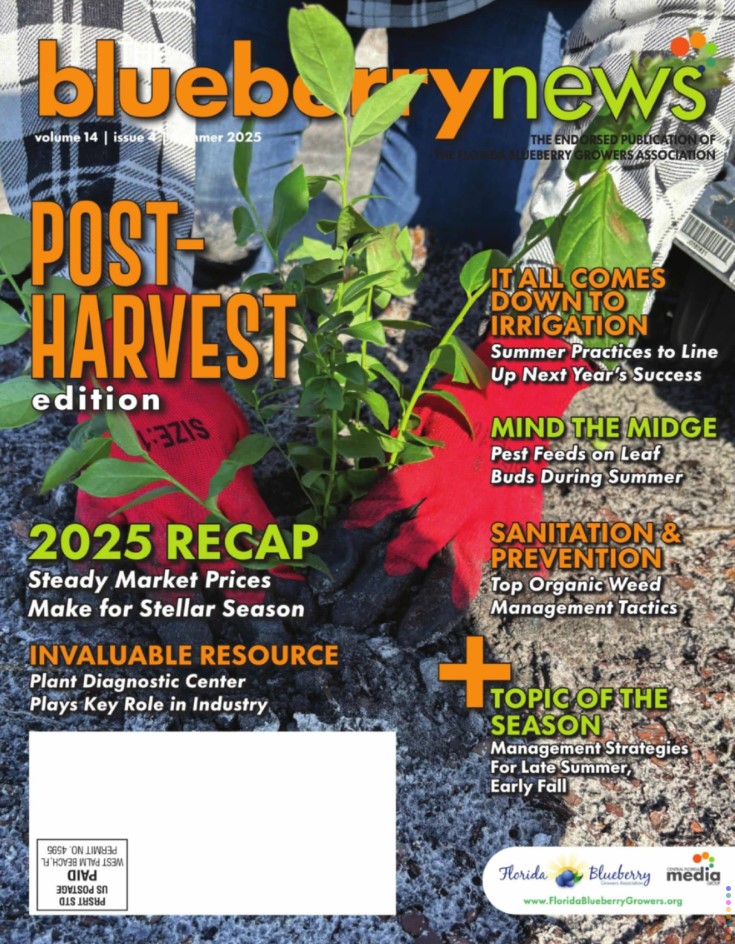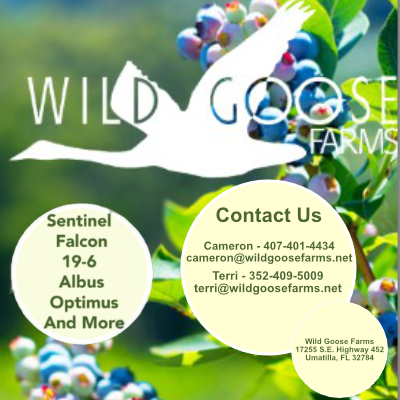Do More Bees Mean More Berries? A Blueberry Pollination Research Update
Blueberry growers know that to get good yields, you need bees. But guidelines for optimal bee stocking densities are limited and outdated. There is also a lack of management recommendations for improving blueberry pollination, especially in Florida. The value provided by pollinators and the limited information available on pollination has led some growers to increase bee stocking densities with little guarantee that this will improve flower visitation or yields. Over the past two years, we have focused on the following research questions with the goal to develop management recommendations for enhancing pollination, fruit set, and overall yields: 1) Do farms with higher stocking densities of managed honey bees receive more honey bee visits to blueberry flowers? 2) Does a higher visitation rate by managed honey bees result in greater fruit set and yields? 3) Do farms with managed bumble bees see enhanced pollination and yields? And finally, 4) What is the role of wild bees in pollinating southern highbush blueberries in Florida?
Research Activities
In 2019, we measured bee visitation rates to blueberry flowers, fruit set, and yield on four farms in North-Central Florida that used a range in honey bee stocking densities from
3 – 8 hives/acre. In 2020, we expanded our research to include 20 farms from the northern to southern range of production in Florida. Across these 20 farms, growers used a wide range of honey bee stocking densities from 0.75 - 12 hives/acre. These same twenty farms also used a wide range of managed bumble bee stocking densities from 0 – 0.75 quad/acre
(0 – 3 colonies/acre). Importantly, we ensured that both honey bee and bumble bee stocking densities were not significantly related to farm size; larger farms did not bring in more or fewer bees as compared to smaller farms. There was also no relationship between managed bee stocking density and region, or between stocking density and surrounding landscape; farms that brought in more bees were not surrounded by more, or less, agriculture, and farms with similar stocking densities were not clustered in the same production region of Florida. This allowed us to examine the effects of managed bee stocking density separate from any effects that farm size, region, or surrounding habitat may have on pollination and yields. Finally, we made sure all studied farms were at least 2 km from any other blueberry farm, and we made sure that our studied farms did not have neighboring apiaries or know of neighbors with high densities of honey bees. Across all farms in 2019 and 2020, we conducted bee observations throughout the whole bloom period on up to ten dates per farm, recorded honey bee hive density on each date including the number of rented, owned, and “parked” or free hives, and measured fruit set and yield on at least twenty selected bushes of at least two cultivars per farm.
Research Findings
The three main pollinators were honey bees Apis mellifera (~90% of visits), bumble bees Bombus spp. (~6% of visits), and the southeastern blueberry bees Habropoda laboriosa (~3% of visits) (Figure 1). All three bees are effective and important pollinators. On a per crop row per farm basis, higher visitation rates by honey bees, bumble bees, and southeastern blueberry bees were all associated with a significantly higher percent fruit set (Figure 2). Higher visitation rates by honey bees and southeastern blueberry bees were also associated with significantly higher yields (total berry weight per 100 flowers) (Figure 2). Of the three bee pollinators, the southeastern blueberry bee had the greatest effect on both percent fruit set and yield, with each additional bee visit corresponding to a yield increase of 6.52 g per 100 flowers. Activity of the southeastern blueberry bee was highly variable across farms, however. Organically managed farms had significantly more southeastern blueberry bees than conventionally managed farms (organic: 1.03 visits per row per period; conventional: 0.25 visits per row per period), but activity of this bee was not affected by farm size or the landscape surrounding the farm (percent woodland, grassland, or agriculture).
Figure 1. Southeastern blueberry bee Habropoda laboriosa visiting a blueberry flower in Florida. Photo credit: Sarah Anderson
Figure 2. Relationships between honey bee visitation rates (A), bumble bee visitation rates (B) and southeastern blueberry bee H. laboriosa visitation rates (C) per row with estimated percent fruit set and yield per 100 flowers per row of blueberries. Estimated percent fruit set exceeded 100% in cases where counts of fruits at harvest exceeded estimates of total flower production.
We did not see more honey bees visiting blueberry flowers on farms with a higher honey bee stocking density (Figure 3), and we also did not see higher percent fruit set or higher yields (total berry weight per 100 flowers) at farms with higher honey bee stocking densities. However, we did find more bumble bees visiting blueberry flowers on farms with a higher stocking density of managed bumble bees (Figure 4). Farms with higher bumble bee stocking densities also had higher fruit set and yields (total berry weight per 100 flowers).
Figure 3. Relationship between honey bee colony density (hives per acre) and the average number of honey bee visits per 100 m crop row, averaged across sampling periods throughout bloom and adjusted for flower density.
Figure 4. Relationship between bumble bee colony density (quads per acre) and the average number of bumble bee visits per 100 m crop row, averaged across sampling periods throughout bloom and adjusted for flower density.
Preliminary Conclusions and Recommendations for Increasing Pollination
Managed honey bees and bumble bees offer crucial pollination services and can increase fruit set and yield. At the currently used range, however, we did not see significant benefits of increasing honey bee stocking densities. Our findings do not suggest that honey bees are not contributing to pollination; indeed both percent fruit set and yield increased with greater honey bee visitation rates, but rather that increasing honey bee stocking densities does not necessarily result in more honey bees visiting blueberry flowers. There are many explanations for this finding including that honey bees are super generalists attracted to a wide variety of flowers both within and outside of the blueberry field. Honey bee foraging activity levels are also sensitive to weather and to the management and condition of the hive. All of these factors may mean that higher stocking densities of honey bees does not result in more honey bees visiting blueberry flowers. On the other hand, within the currently used range, farms with higher densities of managed bumble bees had greater bumble bee activity and higher yields. Blueberry growers looking to improve their pollination may consider increasing bumble bee stocking densities up to 1 quad per acre (4 colonies per acre) while still maintaining honey bees around the statewide average and historically recommended density of ~ 3 - 4 hives/acre. Our results also suggest that southeastern blueberry bees H. laboriosa support excellent fruit set and yield. However, these bees were infrequently observed on most farms and strategies to increase on-farm populations are not well defined.
Future Research
Over the next three years, we will be continuing this research with funding from the USDA. We will take a manipulative, experimental approach and alter managed honey bee stocking densities on farms, comparing farms with average density (3 – 3.5 hives/acre) to double density (6 - 7 hives/acre). This approach will allow us to better examine whether increasing honey bee stocking densities can improve pollination and yield while controlling for farm management and farm characteristics that can influence these relationships. We also plan to examine why southeastern blueberry bees H. laboriosa vary so significantly across farms, and what management practices increase or decrease their populations. Given the significant impact that this species has on blueberry pollination, management decisions that can increase or conserve their populations could significantly benefit yields.
by DR. RACHEL MALLINGER, Assistant Professor of Entomology, University of Florida& JOHN TERNEST, PhD student in Entomology, University of Florida





